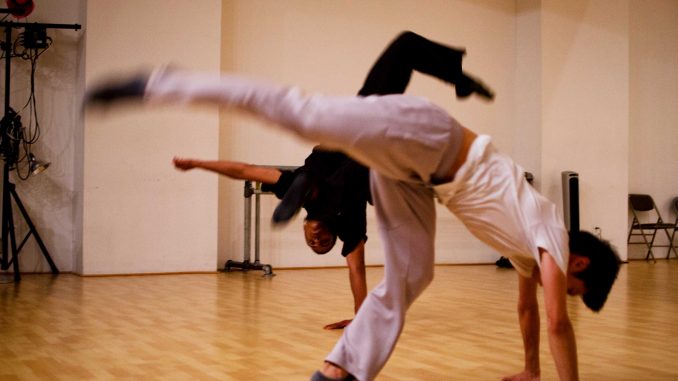
Imagine being able to communicate with anybody in the world, whether you speak his or her language or not. Temple professor Kun-Yang Lin does just that through the art of dance.
Since childhood, Lin lived in a household where gestures and movements of the body were crucial for everyday interaction. Growing up, Lin’s father spoke Mandarin while his mother was Taiwanese, and they never learned each other’s languages while raising a family together.
“My urge for creating has been a healing force in my life,” Lin said. “The process of making art and sharing it with my dancers, students and audiences nourishes me at the deepest levels of my soul.”
As a young boy in Hsin Chu, Taiwan, Lin said he had always been an observer and was curious about why people moved a certain way. He faced many challenges when realizing he was interested in dance, such as disapproval from his family because, as their only son, they wanted him to pursue a professional career that could support his family. Then he was told by a doctor that the structure of his bones would not support dancing. Despite a lower back injury, Lin sees his creative outlet as nourishment.

After being raised in Taiwan, Lin spent some time in Europe and eventually moved to the United States, where spent time in New York and Philadelphia. Lin believes in the idea of carrying our history within our bodies. Having an issue with home and identity, Lin wanted an opportunity to be able to reach deeper within his soul and answer questions pertaining to self identification and how members of a community can interact with one another.
Lin proposed an idea that would let him travel to Indonesia and Taiwan to find this fulfillment that would enhance his creativity, so he could spread it to the community. The trip would also involve three other dance masters: Martinus Miroto from Indonesia, Katsura Kan from Japan, and Hsu-Hui Huang from Taiwan.
Temple plays a large role in the takeoff of this project because they were where one-half of the funds came from. The funders included Independence Fellowships in the Arts as well as Temple’s summer research program.
At a school where people from all over the world come to attend, it is important that all of these influences from throughout different countries can come and share something that they can all enjoy and be a part of. The question is, “what can we all agree on?” and, “how can we find a sense of belonging?”
The answer to those questions is what Lin wants to work on throughout the Be/Longing project by working alongside the other three dance masters in Taiwan and Indonesia.
Ken Metzner, the executive director of Kun-Yang Lin/Dancers had the opportunity to observe the two weeks of movement exploration.
“It was very interesting. [Lin] would give a list of words that went long with belonging, such as rejection, and ask [the other three masters] to show rejection with their bodies, and each person would show it differently. The idea would be to see how they could all show one thing and understand each other through the movement,” Metzner said.
During the two weeks of movement exploration Lin and the other men would practice movement together. They would speak English to one another, though they could speak more fluently with their bodies. Metzner refers to this as, “deep learning and showing movement through beautiful exchange.”
At the festival that was held as the two weeks came to a close, Lin wanted to highlight Temple and show how much it supported him.
Temple gave the opportunity for a research project that will eventually manifest itself into choreography and will be created and shared in Philadelphia. The project was process-based and enriched the artistic process for Lin, who aims to pass this creative energy to his students. Metzner reiterated how important this is for the community.
“Community building is important. We need to find the best in each other and build on that. This project and self-finding that Lin is doing can become a window or prompt for others. Dancing may be Lin’s journey, but this can push others to go on their own personal creative journey,” Metzner said.
With this project, Lin can show others that research does not have to be all about sitting in a lab and looking through books. Research can also be done creatively and as a way to find oneself.
“Dance, as well as this whole project, it’s all very poetic and hard to describe,” Metzner said.
Kun-Yang Lin is currently the creative director of KUN-YANG LIN/DANCERS (KYL/D) and uses his dances to celebrate the body, mind and spirit. Many of his dancers are Temple graduates and he has very diverse dancers due to the result of his approach. Instead of looking for physical attributes he picks dancers who are courageous and open.
There are two big shows coming up in the future for Kun-Yang Lin/Dancers. The first being at the Painted Bride in Old City, Nov. 7-9 and then March 18-22 in the Mandell Theater at Drexel. Metzner foresees that the Be/Longing Project will influence a great deal of the dancing that is done at future shows. Lin said he scatters his shows around the city so that the community can be brought together in order to enjoy the shows and creative energy.
Even the location of his studio was thought out. Being close to the Italian Market, Lin was reminded of his home and Taiwan, which he hoped would influence him.
Lin is a teaching artist that treats his job as a responsibility to the community and will continue to give back to the community throughout the unspoken language of dance.
Chelsea Finn can be reached at Chelsea.finn@temple.edu.



Be the first to comment